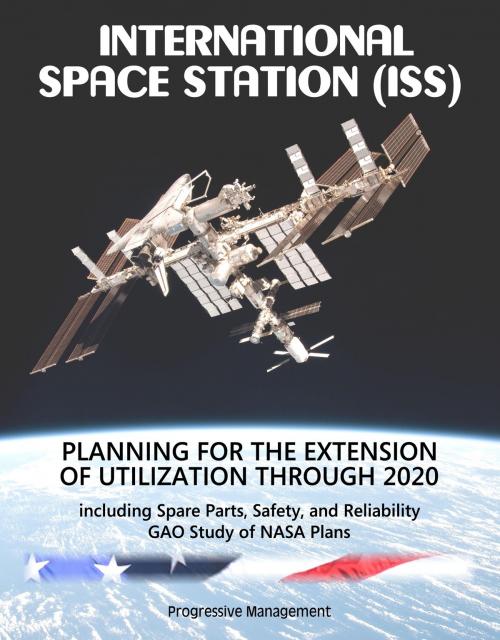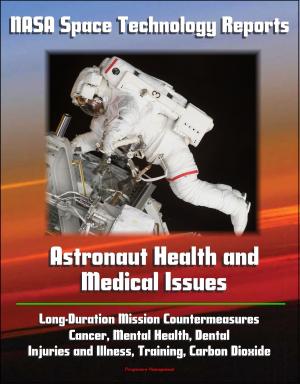International Space Station (ISS): Planning for the Extension of Utilization Through 2020, including Spare Parts, Safety, and Reliability - GAO Study of NASA Plans
Nonfiction, Science & Nature, Science, Physics, Astrophysics & Space Science| Author: | Progressive Management | ISBN: | 9781466070844 |
| Publisher: | Progressive Management | Publication: | March 2, 2012 |
| Imprint: | Smashwords Edition | Language: | English |
| Author: | Progressive Management |
| ISBN: | 9781466070844 |
| Publisher: | Progressive Management |
| Publication: | March 2, 2012 |
| Imprint: | Smashwords Edition |
| Language: | English |
In 2010 the National Aeronautics and Space Administration (NASA) was authorized to extend the life of the International Space Station (ISS) from 2015 through at least September 30, 2020. Gauging the feasibility of doing so is quite complex. Among the factors to be assessed are the reliability of key components, NASA's ability to deliver spares to the ISS, the projected life of structures that cannot be replaced, and the health of systems that affect safety. While some empirical data exist, the ISS is a unique facility in space and assessing its extended life requires the use of sophisticated analytical techniques and judgments. GAO provided a preliminary report on NASA's use of such techniques in April 2011. For this review, GAO assessed the extent to which NASA has ensured essential spare parts are available and ISS structures and hardware are sound for continued ISS utilization through 2020. GAO interviewed NASA officials and outside experts; assessed the methodology underlying NASA's findings; conducted a limited test of data supporting NASA's assessments; and analyzed documentation such as ongoing assessments, schedules and other relevant efforts.
What GAO Found - NASA's approach to determining, obtaining, and delivering necessary spare parts to the ISS is reasonable to ensure continued utilization of the station through 2020. The statistical process and methodology being used to determine the expected lifetimes of replacement units is a sound and commonly accepted approach within the risk assessment community that considers both manufacturers' predictions and the systems' actual performance. To date NASA has given equal weight to manufacturers' predictions and actual performance, and currently has no plans to reassess this decision. However, as time goes on, the resulting estimates could prove to be overly conservative, given that NASA has found failure rates for replacement units to be lower than manufacturers' predictions. Therefore, continuing to weigh the manufacturers' predictions equally with actual performance could lead NASA to purchase an excess of spares. NASA also has a reasonable process for establishing performance goals for various functions necessary for utilization and determining whether available spares are sufficient to meet goals through 2020, but the rationale supporting these decisions has not been systematically documented.
In 2010 the National Aeronautics and Space Administration (NASA) was authorized to extend the life of the International Space Station (ISS) from 2015 through at least September 30, 2020. Gauging the feasibility of doing so is quite complex. Among the factors to be assessed are the reliability of key components, NASA's ability to deliver spares to the ISS, the projected life of structures that cannot be replaced, and the health of systems that affect safety. While some empirical data exist, the ISS is a unique facility in space and assessing its extended life requires the use of sophisticated analytical techniques and judgments. GAO provided a preliminary report on NASA's use of such techniques in April 2011. For this review, GAO assessed the extent to which NASA has ensured essential spare parts are available and ISS structures and hardware are sound for continued ISS utilization through 2020. GAO interviewed NASA officials and outside experts; assessed the methodology underlying NASA's findings; conducted a limited test of data supporting NASA's assessments; and analyzed documentation such as ongoing assessments, schedules and other relevant efforts.
What GAO Found - NASA's approach to determining, obtaining, and delivering necessary spare parts to the ISS is reasonable to ensure continued utilization of the station through 2020. The statistical process and methodology being used to determine the expected lifetimes of replacement units is a sound and commonly accepted approach within the risk assessment community that considers both manufacturers' predictions and the systems' actual performance. To date NASA has given equal weight to manufacturers' predictions and actual performance, and currently has no plans to reassess this decision. However, as time goes on, the resulting estimates could prove to be overly conservative, given that NASA has found failure rates for replacement units to be lower than manufacturers' predictions. Therefore, continuing to weigh the manufacturers' predictions equally with actual performance could lead NASA to purchase an excess of spares. NASA also has a reasonable process for establishing performance goals for various functions necessary for utilization and determining whether available spares are sufficient to meet goals through 2020, but the rationale supporting these decisions has not been systematically documented.















